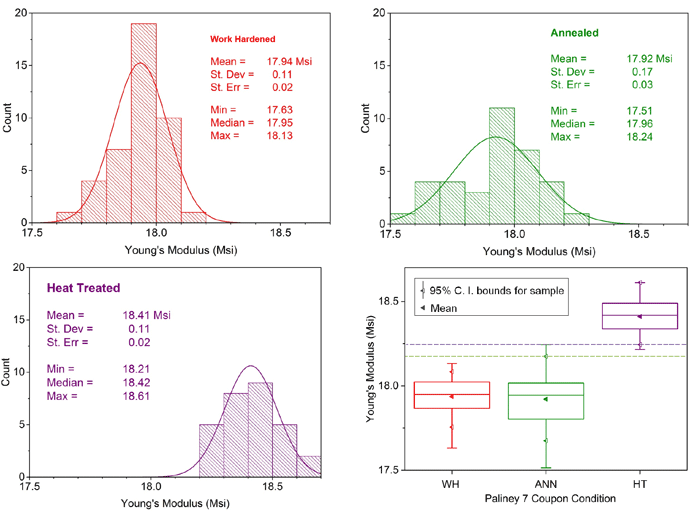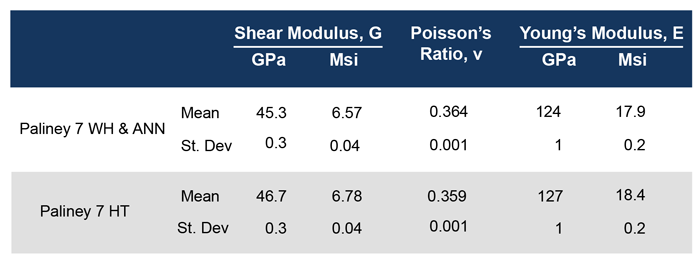Issue 018, October 20, 2021
Patrick K. Bowen, Ph.D., R&D Manager
The age hardenable Pd-Ag-Cu-Au-Pt-Zn alloy Paliney 7 (ASTM B541) is a workhorse material in myriad applications, including: signal-level sliding electrical contacts, semiconductor test pins, and glass-to-metal sealing. Commonly used tempers of the alloy include familiar conditions, like “annealed,” “stress relieved” (a partial anneal), or “cold worked.” Phase transformations that occur at about 700-900°F (370-480°C) may also be leveraged to impart high hardness and strength to Paliney 7; material that receives this thermal treatment is designated “heat treated” (HT).
As discussed in a previous Tech Brief [Note 1], the load-deflection behavior of a cantilever beam depends upon the Young’s modulus of the material. It is known that the Paliney 7 alloy undergoes structural transformations during the age hardening reaction [2], which gave rise to the question: Does age hardening change the elastic (Young’s) modulus of Paliney 7?
Ultrasonic wave velocity measurements were made on Paliney 7 coupons in the work hardened (n=21), annealed (n=18), and heat treated (n=15) conditions. Nominal sample thickness was 0.025 in (0.635 mm). Tests for significant differences used the student’s t-test. Observed Young’s moduli in all three conditions are presented in Figure 1.

Figure 1: Statistical analysis of Young’s modulus for Paliney 7
The cold worked and annealed materials exhibited the same (p=0.64) Young’s modulus, about 17.9 Msi (123 GPa). In contrast, the heat treated temper averaged about 18.4 Msi (127 GPa), which differed significantly from cold worked (p=10-27) and annealed (p=10-21). A full list of the elastic constants recommended for modeling and design with Paliney 7 is shown in Table 1 to three significant digits.

Table 1: Elastic constants for Paliney 7 for cold worked (CW), annealed (ANN), and heat treated (HT) tempers
Susan et al. [2] experimentally verified that Paliney 7 age hardens through a mechanism known as spinodal decomposition, wherein a single face centered cubic (FCC) phase undergoes solid state decomposition into two other FCC phases with slightly different compositions (α→α1 + α2). The reaction creates fluctuations of composition on a length scale of nanometers.
Surprisingly, little information is available on the effect of spinodal decomposition on the Young’s modulus of alloys. This is despite the popularity and engineering importance of some alloy systems, like copper-nickel-tin [3].
A somewhat related report was made by Singh et al. [4] in 2011. The authors noted large changes in Young’s modulus between rapidly solidified and cast samples of an experimental, high-entropy AlCoCrCuFeNi alloy, which displayed signs of spinodal decomposition. Differences in modulus between cast and rapidly solidified samples, as measured by the nanohardness technique, were ascribed to variation in the number of microconstituents. They reported at least three distinct phases in the cast microstructure, but only a single body centered cubic phase from rapid cooling. However, the work did not delve into age hardening by spinodal decomposition, nor were modulus values compared before and after the age hardening heat treatment.
In view of the results presented here, dependence of Young’s modulus on age hardening for certain engineering materials should be considered. This is particularly important for modeling and design of critical applications that consider elastic deflection of an electrical contact member.
Notes:
[Note 1] This is an abbreviated summary of results that were previously presented at the 2018 TMS Annual Meeting in Phoenix, AZ [5]
[Note 2] Paliney® is a registered trademark of Deringer-Ney Inc.
References:
[1] Justice GG. Load – Deflection Characteristics of Buckling and Bending Electrical Contacts. Deringer-Ney Tech Briefs [Internet]. 2021 Jul 21;(14). Available from: https://www.deringerney.com/resource-library/
[2] Susan DF, Ghanbari Z, Kotula PG, Michael JR, Rodriguez MA. Characterization of Continuous and Discontinuous Precipitation Phases in Pd-Rich Precious Metal Alloys. Metall Mater Trans A. 2014, Aug 1;45(9):3755–66.
[3] Raymond W, Cribb F, Gedeon MJ, Grensing FC. Copper-Nickel-Tin Spinodal Alloys. Adv Mater Process. 2013;20.
[4] Singh S, Wanderka N, Murty BS, Glatzel U, Banhart J. Decomposition in multi-component AlCoCrCuFeNi high-entropy alloy. Acta Mater. 2011 Jan;59(1):182–90.
[5] Bowen PK, Birdsall D, Smith EF, Laitila EA. Elastic modulus and structural changes upon age hardening of a palladium-based alloy, Paliney 7. TMS Annual Meeting & Exhibition; 2018 Mar 11; Phoenix AZ.
